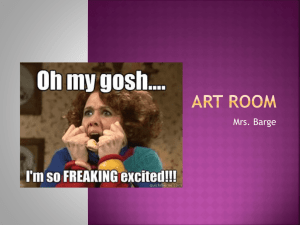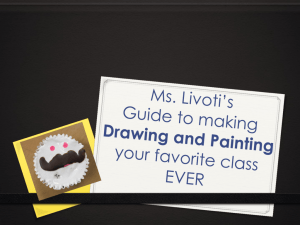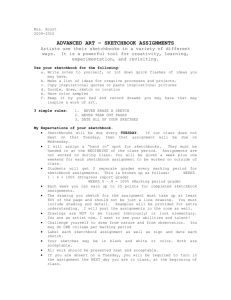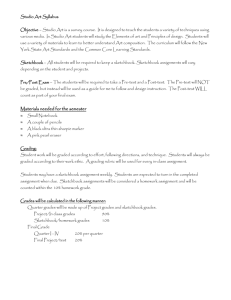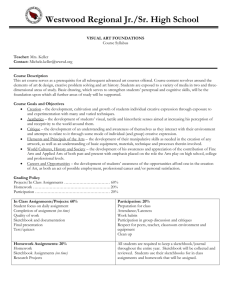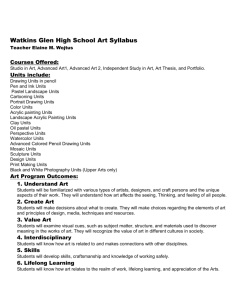Art 6 Syllabus - Jones' Art Space
advertisement
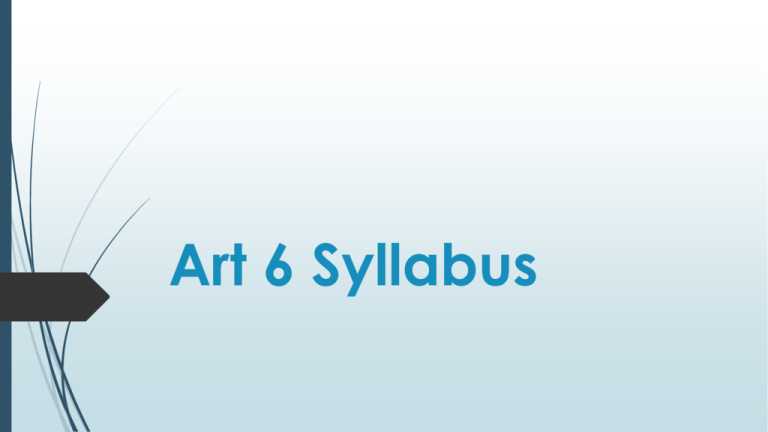
Art 6 Syllabus Welcome to the ART ROOM! The goal of this class is to instill students with an enthusiasm and appreciation of the visual arts and to develop the skills necessary for critical analysis, evaluation, problemsolving, and self-expression. We will be experimenting with a variety of 2D and 3D media while exploring art and ideas from an array of artists, cultures, and art historical periods. I believe that every person is an artist in his or her own unique way. It’s not about having a “natural” talent. It’s about your experiences and explorations throughout the process. You will do well in this class if you put in the effort and do your best! Please visit the class website for information on current projects and other fun art stuff! www.jonesartspace.weebly.com Things you will need: The following items are required to be brought in by Friday, Sept. 11th. $3 for a Sketchbook (provided by me at time of payment) 1 bottle of hand soap *Optional: an old, oversized button-down shirt or an apron to donate to the class for students to use as a smock (this will not be returned) A Positive Attitude- you CAN do it! If you are unable to obtain any of these items, you must bring a note from your parent/guardian. Classroom Procedures Come in quietly. Put your bag by the back door, get your sketchbook, and go to your seat. Warm-up: Begin working immediately on your warm-up. This is a SILENT time. At the signal, give Mrs. Jones your full attention for the day’s lesson and discussion. (Anytime you hear the signal, you should stop what you’re doing and give your attention to Mrs. Jones) During studio time, work hard, speak softly, and use your silent signals. When told to cleanup, STOP working and begin cleanup. Always listen to cleanup instructions before getting out of your seat. After cleanup, return to your seat and sit quietly. Stay seated until I dismiss you. (Note: I dismiss you, not the bell) PLEASE push in your chairs before you leave. Classroom Rules Class rules help make the art room a positive and safe environment for everyone to learn. These rules are based on safety, respect, and responsibility. You are expected to follow the class rules at ALL times and behave in a responsible manner. You are at school to learn, not to play. Classroom Rules: Safety I will use art supplies safely and properly. I will stay in my seat unless given permission to get up. If I need something, I will raise my hand and wait patiently for the teacher’s attention. I will walk carefully around the art room and keep my hands to myself. (No running or rough-housing) Classroom Rules: Respect I will be kind and respectful to everyone and everything. During class discussions, I will give my full attention to the person who is speaking. During work time, I will talk quietly and use appropriate language. Classroom Rules: Responsibility I will come to class on time and prepared to learn. I will be responsible for my work area and clean up after myself. I will use my time in class wisely and will get my work completed on time. Consequences Failure to follow the classroom rules and procedures will result in the following: 1st: Verbal warning 2nd: Consequence Card 3rd: Detention and phone call home 4th: Conference with parents Timeouts and Discipline Referrals will be given for continuous disrespect and extreme circumstances. Curriculum The study of art incorporates many different things, and can be defined as “the process whereby one learns how to produce art, engage in the aesthetic and critical analysis of art, and to talk, read and write about art.” So we will be doing a combination of making art, interpreting and talking about art, as well as reading and writing about art. Curriculum Cont. Each Project will consist of: Process art (technique building), Vocabulary, Quiz, Final project, and Rubric/reflection. Rubrics and Reflections After each project, you will complete a written reflection and rubric. I will use the same rubric when grading and will take your “self-grade” into consideration. The biggest thing I will look at when grading is EFFORT! Your grade is not based on your “natural” talent. It is based on how hard you try! Rubric Example CRITERIA EXCELLENT GOOD SATISFACTORY NEEDS IMPROVEMENT POOR INCOMPLETE Project Criteria 1: I thoughtfully considered the sketchbook topic and thoroughly illustrated my ideas. 5 4 3 2 1 0 Project Criteria 2: I created a 5 composition and filled the whole page with details. Artsmanship & Effort: I put extra effort 5 into my work to make it look neat and complete. Time Management: I used my time in 5 class wisely by staying on task and working hard to complete my project on time. 4 3 2 1 0 4 3 2 1 0 4 3 2 1 0 Reflection Example 1.What is something you learned about Pablo Picasso? 2.What did you learn about Cubism? Can you name at least two ways to identify Cubism? 3.Did you enjoy creating this artwork? Why or why not? 4.What is something you feel you did really well on your project? 5.What is something could you have done to make your artwork better? Sketchbooks Artists use sketchbooks as a tool for thinking through their creative process or to get their creative juices flowing! Each Monday will be sketchbook day. On Mondays you will be given a topic on which to create a full-page composition in your sketchbook. You will have the entire class period on Monday and 20 minutes on Tuesday or Wednesday to work on your sketchbook. Each sketchbook assignment will be due at the beginning of class the following Monday. Be sure to use consecutive pages!!! Sketchbooks may also be used for other project related work as well. Sketchbooks should be left in the classroom and completed during class time. However, if you would like to bring your sketchbook home to work on it you can. BUT YOU MUST BRING YOUR SKETCHBOOK TO CLASS EVERYDAY! Examples: Excellent Sketchbooks Warm-ups Everyday when you come into class, you will have a warm-up. The warm-up for the day will be displayed on the overhead, so be sure to read it as soon as you enter the room Warm-ups will always be done in your sketchbook If you’re the first person at your table to enter the room, you should get your sketchbook bin out of your table cubby. Warm-up is always a SILENT TIME. This means no talking or making other noises. No questions or requests to go to the bathroom at this time. WARM-UP SCHEDULE Mondays (5 mins): Read the sketchbook topic for the week and brainstorm ideas Tuesday/Wednesday (20 mins): Work on that week’s sketchbook Thursday/Friday (5 mins): Vocab, art research, or other activity Art Research and Vocabulary Warmups Every Thursday, I will post an art topic you will be researching. You need to write at least three sentences that accurately describe the person or art topic- enough words so that someone reading it would be able to understand what it is you are talking about. Every Friday, I will post a list of 3-5 vocabulary words you will need to write down the definition of. These words will be part of your project quiz. BOTH OF THESE ASSIGNMENTS SHOULD BE DONE IN YOUR SKETCHBOOK FOLLOWING THE SKETCHBOOK DRAWING FOR THAT WEEK. THEY WILL BE GRADED ON MONDAYS ALONG WITH YOUR SKETCHBOOK ASSIGNEMENT Late Work Any assignments that are not turned in on time will have 10 points taken off. Students have until the end of the marking period to turn in late work. Any work not turned by the end of the 9 weeks will be recorded as a 0 and can no longer be made up for a grade. ReDos Any student who wishes to increase their grade on an assignment may work to improve it after it has been graded and returned. Assignments can be resubmitted at any time within the quarter it was assigned for an opportunity to earn a higher grade. The project MUST be submitted with the original, graded rubric. Wish List The Art Department could always use more supplies, and some of them can be found in your recycling bin! It is certainly not expected, but any materials you would like to donate would be greatly appreciated! egg cartons Q-tips plastic gallon milk jugs sponges plastic containers of all shapes and sizes Mod Podge tissue paper Sta Flo liquid starch aluminum foil wooden dowel rods gallon size ziplock bags toilet paper/paper towel rolls wax paper newspaper dried pasta and beans magazines (age-appropriate) disinfectant wipes hand sanitizer buttons and beads
